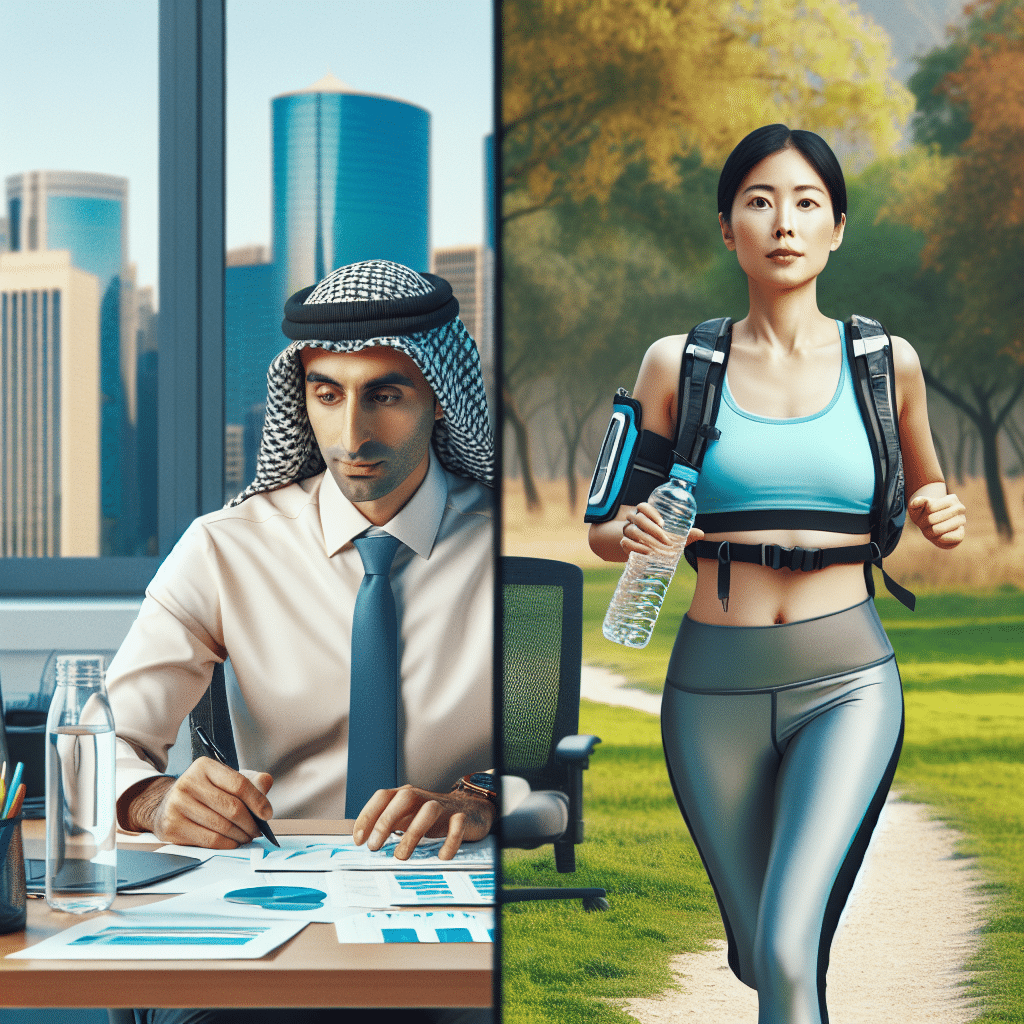Understanding Hydration: Why It Matters
Maintaining proper hydration is essential for achieving peak performance in both office environments and active lifestyles. Dehydration can lead to fatigue, decreased concentration, headaches, and other serious health issues. Knowing how to stay adequately hydrated, especially during the workday and while engaged in physical activities, is vital for overall wellness.
Hydration Basics
Daily Water Intake Recommendations
The Institute of Medicine recommends a daily water intake of about 3.7 liters for men and 2.7 liters for women, including all beverages and foods. Factors such as body weight, climate, and physical activity levels will influence individual hydration needs.
Signs of Dehydration
Be aware of symptoms indicating dehydration, such as:
- Thirst
- Dry mouth
- Fatigue
- Dark yellow urine
- Dizziness
Recognizing these signs early can help you take measures to rehydrate promptly.
Hydration Tips for Office Workers
-
Keep a Water Bottle Handy
Having a reusable water bottle at your desk makes it easier to drink water throughout the day. Aim for a bottle that holds at least 500 ml, and set a goal to refill it. -
Set Reminders
Schedule reminders using your smartphone or calendar to drink water every hour. A simple alarm can prompt you to take a hydration break. -
Infuse Your Water
If plain water doesn’t excite you, try infusing it with fruits, herbs, or vegetables. Lemon, cucumber, mint, and strawberries add flavor without calories, making hydration enjoyable. -
Track Your Intake
Use hydration apps or journals to monitor your daily water consumption. Seeing your progress can motivate you to meet your hydration goals. -
Drink Before You Snack
Make it a habit to drink water before a snack. This will not only help you stay hydrated but may also curb excessive snacking, promoting healthier eating habits.
Hydration Tips for Active Lifestyles
-
Pre-Hydration Before Exercise
Drink water before engaging in physical activities. Aim for approximately 500 ml one to two hours before working out to optimize your performance. -
Electrolyte Drinks for Endurance
During prolonged physical activities (more than 60 minutes), consider electrolyte drinks. These replenish sodium, potassium, and magnesium lost through sweat, providing better hydration than water alone. -
Post-Workout Hydration
Rehydrate after exercising by drinking about 1.5 liters of water for every kilogram lost during your workout. This can help accelerate recovery and restore fluid balance. -
Monitor Urine Color
A quick way to gauge your hydration status is through urine color. Pale yellow indicates good hydration, while darker shades suggest it’s time to drink more water. -
Hydration During Outdoor Activities
For outdoor activities, particularly in hotter climates, be especially mindful of hydration. Carry a hydration pack or water bottle, and take sips regularly to avoid fatigue.
Creative Hydration Solutions
-
Hydrating Foods
Incorporate foods with high water content into your diet, like cucumbers, watermelon, oranges, and lettuce. These not only hydrate but add nutrition to your meals. -
Herbal Teas and Broths
Herbal teas, both hot and cold, are great alternatives to pure water. Bone broth or vegetable broths also contribute to hydration and are nutrient-rich. -
Hydration Challenges
Make drinking water fun by setting hydration challenges with coworkers or friends. A little friendly competition can motivate everyone to stay hydrated. -
Cooking with Water
Use water-rich ingredients while cooking. For example, cook rice or grains in broth instead of water for added flavor and added nutrition.
FAQs About Hydration
-
Can I hydrate with coffee and tea?
Yes, while caffeinated beverages can act as mild diuretics, they can still contribute to your daily hydration needs. Moderation is key. -
Is drinking too much water harmful?
While hydration is beneficial, excessive water intake can lead to water intoxication or hyponatremia. Always listen to your body’s cues. -
Do I need to drink water if I’m not thirsty?
Yes, it’s wise to drink water regularly, even if you do not feel thirsty, particularly in dry climates or during intense physical exertion.
Maintaining Hydration at Work Events
-
Stay Ahead During Meetings
Bring a water bottle to meetings and workshops. Staying hydrated keeps your mind sharp and engaged. -
Choose Hydrating Snacks
When selecting snacks for work events, opt for fresh fruits, veggies, or yogurt. These options not only provide hydration but are healthier than typical snack foods. -
Drink Water During Breaks
Schedule short breaks between tasks to step away from your desk and drink water. Use this time to stretch, reducing physical strain.
The Role of Technology in Hydration
-
Smart Water Bottles
Consider investing in a smart water bottle that tracks your intake and reminds you to drink. These innovations can help you stay conscious of your hydration habits. -
Apps to Track Water Intake
Download apps that allow you to log your water consumption. Many apps provide personalized goals based on your activity level, making it easier to stay on top of your hydration. -
Wearable Hydration Monitors
Emerging technology includes wearables that monitor hydration levels, which can provide real-time feedback about your fluid needs.
Final Thoughts on Hydration
In both office and active environments, hydration is a cornerstone of productivity and health. By implementing systematic hydration tips and leveraging available technology, you can ensure that you remain hydrated throughout your busy days. Always prioritize water intake, listen to your body, and enjoy the refreshing benefits of proper hydration in your daily life.
